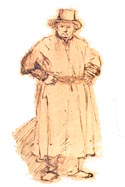

|
 When scholars began to study Rembrandt in the nineteenth and early twentieth centuries they were surprised by the large number of self portraits. It was discovered that he had painted himself on at least forty occasions, had etched himself thirty-one times, and made a handful of drawings. This segment of his oeuvre is unique in art history, not only in its scale and the length of time it spans, but also in its regularity. New self portraits appeared almost annually, and sometimes several times a year. The magnificent variety of both painted and etched self portraits demonstrates that Rembrandt saw them as experimental forcing-grounds for his painterly and graphic adventures. When scholars began to study Rembrandt in the nineteenth and early twentieth centuries they were surprised by the large number of self portraits. It was discovered that he had painted himself on at least forty occasions, had etched himself thirty-one times, and made a handful of drawings. This segment of his oeuvre is unique in art history, not only in its scale and the length of time it spans, but also in its regularity. New self portraits appeared almost annually, and sometimes several times a year. The magnificent variety of both painted and etched self portraits demonstrates that Rembrandt saw them as experimental forcing-grounds for his painterly and graphic adventures.
 The works in this exhibit were chosen to show the development of Rembrandt's style from his early days in Leiden to his last days in Amsterdam. For this exhibit the self portraits have been divided into three sections. The paintings section contains fourteen paintings with Rembrandt alone. The scenes section has five paintings with Rembrandt in costume. The last section contains eight self portrait etchings. The works in this exhibit were chosen to show the development of Rembrandt's style from his early days in Leiden to his last days in Amsterdam. For this exhibit the self portraits have been divided into three sections. The paintings section contains fourteen paintings with Rembrandt alone. The scenes section has five paintings with Rembrandt in costume. The last section contains eight self portrait etchings.
 Rembrandt occupies his very own place among Dutch seventeenth-century painters. Through out the years his technique changed, but his style remained personal and recognizable. He had many pupils to whom he taught his 'manner', as well as followers who attempted to learn and assimilate by themselves. The stories told about Rembrandt and his studio prove very clearly, that Rembrandt made a unique impression on those who came to work with him. He inspired his pupils with his openness to bring out their individual capabilities so each painter would ultimately find his own way. Rembrandt occupies his very own place among Dutch seventeenth-century painters. Through out the years his technique changed, but his style remained personal and recognizable. He had many pupils to whom he taught his 'manner', as well as followers who attempted to learn and assimilate by themselves. The stories told about Rembrandt and his studio prove very clearly, that Rembrandt made a unique impression on those who came to work with him. He inspired his pupils with his openness to bring out their individual capabilities so each painter would ultimately find his own way.
 In order to provide an accurate record as possible of all the important dates in Rembrandt's life, from his birth to his burial in a rented grave numerous sources were researched. In order to provide an accurate record as possible of all the important dates in Rembrandt's life, from his birth to his burial in a rented grave numerous sources were researched.
|


